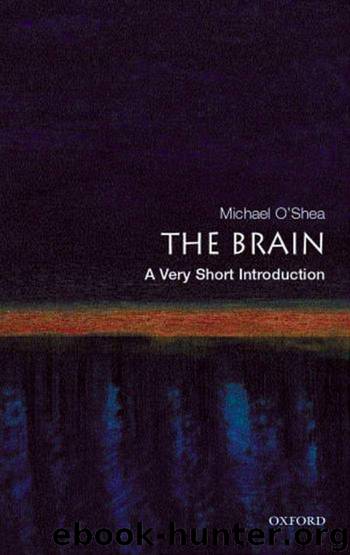The Brain : A Very Short Introduction by Michael O'Shea

Author:Michael O'Shea
Language: eng
Format: mobi
Published: 2010-10-28T16:55:35.199000+00:00
12. Eye and retina. Light entering the eye passes through two layers of neurons in the retina before reaching the light-sensitive photoreceptors – the rods and cones. Information about the quality of the light is then passed back to the neurons, which integrate and transform it into a pattern of impulses for transmission to the brain by a million retinal ganglion cells
our rod photoreceptors have adapted to the reduced intensity by increasing their sensitivity. Resetting sensitivity depends on the mobilization of biochemical mechanisms in the photoreceptors and can take a few minutes to complete for a very large change in light intensity. As a consequence of light adaptation, the brain is not informed about the absolute levels of brightness but about rather more useful information about local differences in brightness and contrast, regardless of the overall brightness.
Information travels to the brain from the eyes as trains of nerve impulses carried by the axons of the retinal ganglion cells. Each ganglion cell has a unique view on the visual world, called its receptive field. This is the small roughly circular region of the world, light from which can affect the electrical activity of a particular ganglion cell. There are roughly equal numbers of two different types of receptive fields of retinal ganglion cells, those that are excited by an increase in light intensity at the centre of their receptive field (ON centre ganglion cells) and those that are excited by a decrease in central intensity (OFF centre). By reporting an increased rate of firing for both ON centre and OFF centre receptive fields, a more reliable signal is generated than by reporting an ON response with an increased rate and an OFF response with a decreased rate from an already low firing frequency.
Vision is an active information acquisition process – the eyes dart about frenetically under the direction of the brain. As we have already discovered, clear vision is possible only when the fovea inspects a scene. This provides a very restricted window of clarity and so to generate the perception of a ‘movie in the head’ the eyes must be moved around. The eyes move speedily from one place to another where they dwell for a while, enabling your brain to take a high definition snapshot. From a number of these sequential snaps the brain builds the mind’s eye picture of the outside world. The whole process is an active feedback loop in which the retina supplies information to the brain, which then makes an educated guess about what is out there and on this basis instructs the eyes to move, thereby changing the visual information being supplied. Multiple brain regions are required to perform all of the computational tasks that are necessary to convert information supplied by the eyes into the richness of perception that constitutes cinematic awareness of the visual world.
The pathway from the eye to the brain starts where the axons of the retinal ganglion cells exit the retina forming the optic nerve. At this point, called the optic disc, there are no photoreceptor cells to allow the ganglion cell axons to exit.
Download
This site does not store any files on its server. We only index and link to content provided by other sites. Please contact the content providers to delete copyright contents if any and email us, we'll remove relevant links or contents immediately.
Periodization Training for Sports by Tudor Bompa(8171)
Why We Sleep: Unlocking the Power of Sleep and Dreams by Matthew Walker(6618)
Paper Towns by Green John(5092)
The Immortal Life of Henrietta Lacks by Rebecca Skloot(4526)
The Sports Rules Book by Human Kinetics(4296)
Dynamic Alignment Through Imagery by Eric Franklin(4118)
ACSM's Complete Guide to Fitness & Health by ACSM(3989)
Kaplan MCAT Organic Chemistry Review: Created for MCAT 2015 (Kaplan Test Prep) by Kaplan(3940)
Introduction to Kinesiology by Shirl J. Hoffman(3726)
Livewired by David Eagleman(3685)
The Death of the Heart by Elizabeth Bowen(3553)
The River of Consciousness by Oliver Sacks(3542)
Alchemy and Alchemists by C. J. S. Thompson(3451)
Bad Pharma by Ben Goldacre(3357)
Descartes' Error by Antonio Damasio(3230)
The Emperor of All Maladies: A Biography of Cancer by Siddhartha Mukherjee(3068)
The Gene: An Intimate History by Siddhartha Mukherjee(3048)
The Fate of Rome: Climate, Disease, and the End of an Empire (The Princeton History of the Ancient World) by Kyle Harper(3003)
Kaplan MCAT Behavioral Sciences Review: Created for MCAT 2015 (Kaplan Test Prep) by Kaplan(2941)
